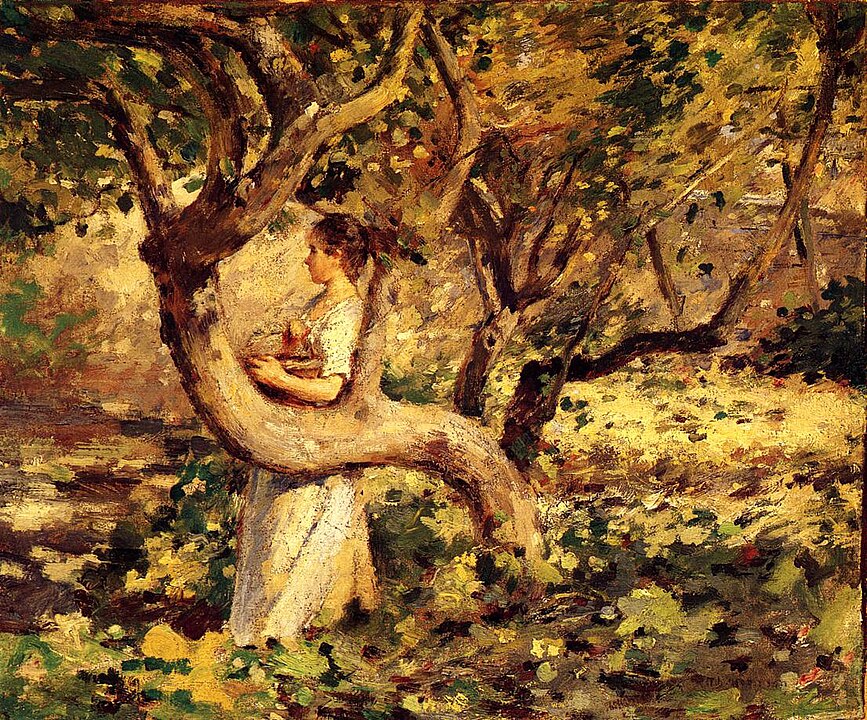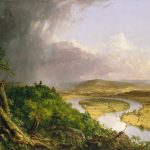
Theodore Robinson (1852-1896) was an American painter associated with the influential art movement known as Impressionism. Born in Irasburg, Vermont, on June 3, 1852, Robinson’s early life was marked by a deep connection to nature, a theme that would later become prominent in his artistic endeavors.

Raised in rural Vermont, Robinson displayed an early aptitude for art. Recognizing his talent, his family supported his artistic pursuits, and he eventually enrolled at the National Academy of Design in New York City in 1869. Under the guidance of influential artists such as Lemuel Wilmarth and Thomas Eakins, Robinson honed his skills and developed a keen interest in capturing the essence of light and atmosphere in his paintings.
In the early 1870s, Robinson embarked on a journey to Paris, a city that was at the forefront of the art world during that period. He enrolled at the École des Beaux-Arts and later became a student of academic painter Jean-Léon Gérôme. However, Robinson’s artistic vision underwent a profound transformation when he encountered the works of the French Impressionists, particularly Claude Monet.

Inspired by the innovative techniques and revolutionary approach to color and light employed by the Impressionists, Robinson embraced this avant-garde movement. He became captivated by the idea of painting en plein air, or outdoors, allowing him to directly observe and capture the changing effects of light on the landscape.

Robinson’s return to the United States in 1876 marked the beginning of his career as a professional artist. Settling in New York, he became a central figure in the emerging American Impressionist movement. His work was characterized by a focus on rural landscapes, often featuring scenes from his hometown in Vermont or picturesque locations in the Northeast.
One of Robinson’s notable contributions to American Impressionism was his role in organizing the first exhibition of this artistic style in the United States. In 1886, he curated an exhibition titled “American Artists in Paris,” which showcased the works of American artists who had been influenced by the Impressionist movement. This exhibition played a crucial role in introducing and popularizing Impressionism in the American art scene.

Throughout his career, Robinson maintained close ties with fellow artists and was actively involved in various artistic societies. He was a founding member of the Society of American Artists, an organization that sought to challenge the traditional academic norms and promote innovative approaches to art. Robinson’s commitment to fostering a sense of community among artists contributed to the growth and acceptance of Impressionism in the United States.

Despite facing financial challenges, Robinson continued to produce a remarkable body of work. His paintings often featured a harmonious blend of colors, capturing the fleeting effects of light and atmosphere. Notable works include “Low Tide, Tynemouth” and “The Old Mills of Brookville,” both exemplifying his mastery of the Impressionist technique.
Tragically, Theodore Robinson’s life was cut short when he succumbed to asthma-related complications at the age of 43 in 1896. However, his legacy endured through his contributions to American Impressionism. His influence extended beyond his own paintings, as he played a pivotal role in shaping the trajectory of the American art scene during a transformative period.

In recognition of his impact, retrospectives of Robinson’s work have been organized, celebrating his unique contributions to the art world. His legacy lives on in the continued appreciation of his paintings, which not only captured the beauty of the American landscape but also played a crucial role in the development of Impressionism in the United States. Theodore Robinson remains a pivotal figure in the history of American art, remembered for his innovative spirit and dedication to capturing the nuances of light and nature on canvas.




